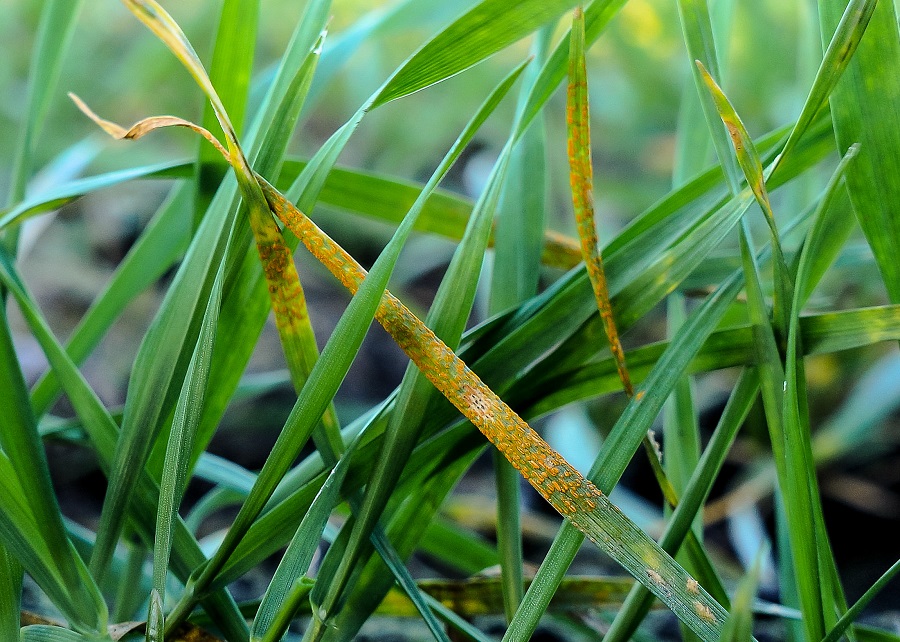As crops start to emerge from the winter, focus is turning to spring management in order to get crops in optimum condition ahead of the main growth period.
And with increasing reports of yellow rust in the base of crops – teamed with a reduced crop protection toolbox this season – building plant health to promote disease resilience the natural way could be particularly valuable this spring, says Stuart Sutherland, technical manager at Interagro. “Improving host plant defences by optimising plant health early in the season has been shown to be effective in helping low/medium disease resistant varieties to fight yellow rust infection and protect yield later on.
“This is where biostimulant products – such as Bridgeway and Zonda – can play a really beneficial role, and they’ve continually demonstrated their abilities to help plants overcome the effects of stress by improving overall health.”
These claims were tested in 2020 NIABTAG trials where the application of Bridgeway at T0 proved to reduce yellow rust and increase yield.
“In these trials, we looked specifically at the effect of Bridgeway on Gleam – a moderate disease resistance variety – and Gravity, a low disease resistance, high input variety,” explains Stuart.
“Looking firstly at Gleam, the yellow rust percentage was assessed on 29 June, and found that where Bridgeway was applied at T0, infection levels were significantly reduced.
“Financially, a T0 application of Bridgeway stacked up too – with significant yield increases and subsequent margins. Compared with when Gleam was left untreated, this approach offered a yield increase of 1.10t/ha and a £91 margin over input cost.”

The same results were seen in the Gravity trial plots – with this variety seen as having low disease resistance and requiring a high fungicide input, he adds. “Where Bridgeway was used at T0 – followed by Ascra at T1 and T2 – a yield increase of 0.82t/ha was seen (compared with untreated crops at T0).”

As well as disease pressure, with a mini heatwave at the end of March followed by a nose-dive temperature wise, there are concerns this could cause crops to take a backwards step, adds Stuart. “This could be a further reason to consider Bridgeway or Zonda at T0 – amino acids and signalling peptides in Bridgeway provide the crop with an immediate supply to fight against stress. This is key to helping crops tolerate stressful growing conditions. Without Bridgeway/Zonda, crops have to breakdown proteins they have made to source the amino acids and peptides needed to cope with stress, like proline, which is very energy intensive.”
View from the field
Having seen the benefits of Zonda first-hand, Agrii agronomist – Charlie Catto – says he’ll be using the amino-acid based product to ‘wake up’ crops in north east Scotland this spring.
“It’s been quite a hard winter. In some places, temperatures dropped to -16oc. As a result, some of the crops are looking a bit stressed nutrition wise, though they did establish well in the autumn.”
Charlie has been using and recommending Zonda for three years and says he’s continually impressed with way it helps crops protect and fight against stress, which will no doubt be beneficial this spring. “In general, I like to use it at T1. Zonda is a biostimulant, with a deposition aid “built-in” which means we can also reduce/refine fungicide usage, on top of getting the stress-busting benefits.
“As we move towards more environmentally-friendly agronomy, this can help to reduce reliance on chemistry.”
On more progressive farms, Charlie says Zonda is often used at T0, T1 and T2, and the results can be very beneficial. “It’s a really flexible product and has proven itself to work in a variety of situations. I find its particularly useful on spring barley at flag leaf, used alongside something like folpet. Ramularia is a major issue for spring barley growers, and now we’ve lost chlorothalonil it’s really good to have something that just helps the plant fight off disease.”
As well as using Zonda to kick-start spring growth this year, Charlie says he’ll be recommending its usage as a protective strategy in case of an early season drought. “Over the past few years, we’ve seen really hot and dry spells in April and May which no doubt puts the crops under a lot of stress. While we may not always see a massive yield increase, we do see a reduction in the impact of stress every time which essentially helps to protect that harvest yield.”
Though the use of biostimulants often divides opinions, Charlie says that those who aren’t yet convinced should consider a split field trial to test the benefits themselves. “This year I’m going to be doing a lot more work on the use of Zonda in potatoes and fodder beet. I did a half field trial on beet last year and the difference was remarkable.
“If you never try it, you won’t know but what I can say is that within all my own trials, and from what I’ve seen on farm, making use of a biostimulant really can help boost crop production.”
Bridgeway and Zonda benefits in cereals:
- Improved rooting and nutrient access
- Aids stress recovery
- Builds resilience to stress.
- Builds plant health to fight disease.
- May increase yield and quality.
For more information visit: https://www.interagro.co.uk/plant-health-key-to-resilient-crop-production/




